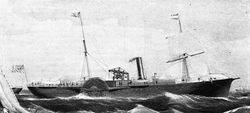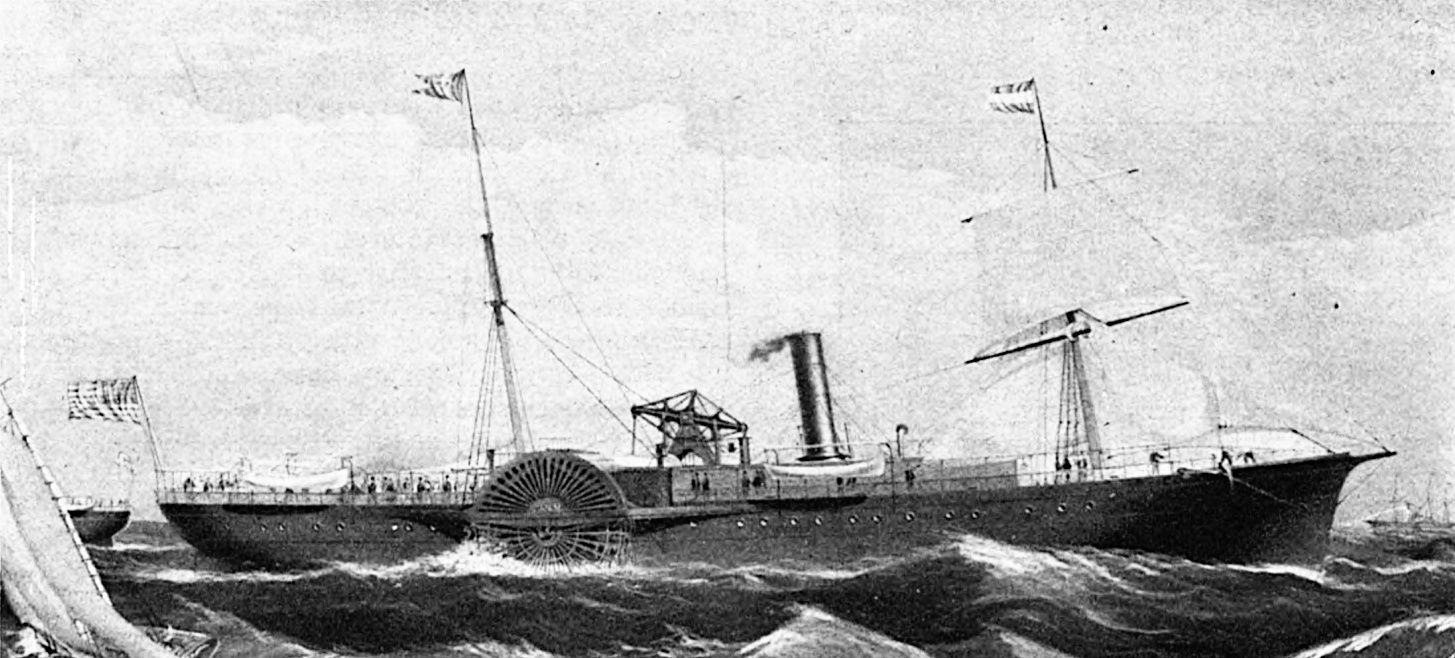Pension Records show service on board USS Bienville and USS North Carolia
U.S. Navy Pensions Index, 1861-1910about Sylvester Abbott
Name: Sylvester Abbott
Publication: M1279
Pension Approval: Approved
File Number: 11399
Certification Number: 13464
USS Bienville (1861) was a 1,558 long tons (1,583 t) (Burden) wooden side-wheel steamship acquired by the Union Navy during the beginning of the American Civil War. She was outfitted with heavy guns and assigned to the Union blockade of the waterways of the Confederate States of America.
Built in Brooklyn, New York
Bienville built at Brooklyn, New York in 1860, was purchased by the Union Navy in August 1861 as part of the great expansion that took place in the first months of the American Civil War.
Civil War operations
Assigned to the South Atlantic blockade
She was commissioned in October 1861 and soon participated in the expedition that seized future Naval bases at Port Royal and Beaufort, South Carolina. Bienville operated off the Confederacy's Atlantic coast for more than a year, taking part in the capture of positions along the Georgia and Florida shore as well as ending the careers of several blockade runners, among them the steamers Stettin (later USS Stettin) (taken on 24 May 1862) and Patras
In 1863, Bienville was transferred to the Gulf of Mexico, where she continued her blockading work. In addition, she supported the capture of the entrances to Mobile Bay, Alabama on 5 August 1864. In an operation typical of the era's coastal warfare, she sent a boat party into Galveston Bay, Texas on the night of 7 February 1865 and seized two schooners loaded with cotton.
Decommissioning and civilian career
Bienville was decommissioned soon after the end of the Civil War. Following some two years in reserve, she was sold in October 1867. Operating under the same name as a commercial steamship, she lasted until 15 August 1872, when a fire destroyed her at Watling Island, Bahamas.
The first USS North Carolina was a 74-gun ship of the line in the United States Navy.
One of the "nine ships to rate not less than 74 guns each" authorized by Congress on 29 April 1816, she was laid down in 1818 by the Philadelphia Navy Yard, launched on 7 September 1820, and fitted out in the Norfolk Navy Yard. Master Commandant Charles W. Morgan was assigned to North Carolina as her first commanding officer on 24 June 1824.
While nominally a 74-gun ship, a popular size at the time, North Carolina was actually pierced (had gunports) for 102 guns, and probably originally mounted ninety-four 42-pounder (19 kg) and 32-pounder (15 kg) cannons. In 1845, she had fifty-six 42-pounders (19 kg), twenty-six 32-pounders (15 kg), and eight 8 in (200 mm) cannons, for a total of 90.
Considered by many the most powerful naval vessel then afloat, North Carolina served in the Mediterranean as flagship for Commodore John Rodgers from 29 April 1825-18 May 1827. In the early days of the Republic, as today, a display of naval might brought a nation prestige and enhanced her commerce. Such was the case as Rodgers' squadron which laid the groundwork for the 1830 commercial treaty with Turkey opening ports of the Eastern Mediterranean and the Black Sea to American traders.
After a period in ordinary at Norfolk, North Carolina decommissioned on 30 October 1836 to fit out for the Pacific Squadron, the one other area where ships of her vast size could be employed. Only the Mediterranean and the western coast of South America at that time offered ports which could accommodate ships of great draft. Again flagship of her station, flying the pennant of Commodore Henry E. Ballard, North Carolina reached Callao, Peru on 26 May 1837. With the War of the Confederation raging between Chile and Peru, and relations between the United States and Mexico strained, North Carolina protected the important American commerce of the eastern Pacific until March 1839. Since her great size made her less flexible than smaller ships, she returned to the New York Navy Yard in June, and served as a receiving ship until placed in ordinary in 1866. She was sold at New York on 1 October 1867.
Please send any additional information you may have on this man. USE EDIT ....
Click Link to see all The Lost Sailors I've Found
http://www.findagrave.com/cgi-bin/fg.cgi?page=vcsr&GSvcid=266131
Pension Records show service on board USS Bienville and USS North Carolia
U.S. Navy Pensions Index, 1861-1910about Sylvester Abbott
Name: Sylvester Abbott
Publication: M1279
Pension Approval: Approved
File Number: 11399
Certification Number: 13464
USS Bienville (1861) was a 1,558 long tons (1,583 t) (Burden) wooden side-wheel steamship acquired by the Union Navy during the beginning of the American Civil War. She was outfitted with heavy guns and assigned to the Union blockade of the waterways of the Confederate States of America.
Built in Brooklyn, New York
Bienville built at Brooklyn, New York in 1860, was purchased by the Union Navy in August 1861 as part of the great expansion that took place in the first months of the American Civil War.
Civil War operations
Assigned to the South Atlantic blockade
She was commissioned in October 1861 and soon participated in the expedition that seized future Naval bases at Port Royal and Beaufort, South Carolina. Bienville operated off the Confederacy's Atlantic coast for more than a year, taking part in the capture of positions along the Georgia and Florida shore as well as ending the careers of several blockade runners, among them the steamers Stettin (later USS Stettin) (taken on 24 May 1862) and Patras
In 1863, Bienville was transferred to the Gulf of Mexico, where she continued her blockading work. In addition, she supported the capture of the entrances to Mobile Bay, Alabama on 5 August 1864. In an operation typical of the era's coastal warfare, she sent a boat party into Galveston Bay, Texas on the night of 7 February 1865 and seized two schooners loaded with cotton.
Decommissioning and civilian career
Bienville was decommissioned soon after the end of the Civil War. Following some two years in reserve, she was sold in October 1867. Operating under the same name as a commercial steamship, she lasted until 15 August 1872, when a fire destroyed her at Watling Island, Bahamas.
The first USS North Carolina was a 74-gun ship of the line in the United States Navy.
One of the "nine ships to rate not less than 74 guns each" authorized by Congress on 29 April 1816, she was laid down in 1818 by the Philadelphia Navy Yard, launched on 7 September 1820, and fitted out in the Norfolk Navy Yard. Master Commandant Charles W. Morgan was assigned to North Carolina as her first commanding officer on 24 June 1824.
While nominally a 74-gun ship, a popular size at the time, North Carolina was actually pierced (had gunports) for 102 guns, and probably originally mounted ninety-four 42-pounder (19 kg) and 32-pounder (15 kg) cannons. In 1845, she had fifty-six 42-pounders (19 kg), twenty-six 32-pounders (15 kg), and eight 8 in (200 mm) cannons, for a total of 90.
Considered by many the most powerful naval vessel then afloat, North Carolina served in the Mediterranean as flagship for Commodore John Rodgers from 29 April 1825-18 May 1827. In the early days of the Republic, as today, a display of naval might brought a nation prestige and enhanced her commerce. Such was the case as Rodgers' squadron which laid the groundwork for the 1830 commercial treaty with Turkey opening ports of the Eastern Mediterranean and the Black Sea to American traders.
After a period in ordinary at Norfolk, North Carolina decommissioned on 30 October 1836 to fit out for the Pacific Squadron, the one other area where ships of her vast size could be employed. Only the Mediterranean and the western coast of South America at that time offered ports which could accommodate ships of great draft. Again flagship of her station, flying the pennant of Commodore Henry E. Ballard, North Carolina reached Callao, Peru on 26 May 1837. With the War of the Confederation raging between Chile and Peru, and relations between the United States and Mexico strained, North Carolina protected the important American commerce of the eastern Pacific until March 1839. Since her great size made her less flexible than smaller ships, she returned to the New York Navy Yard in June, and served as a receiving ship until placed in ordinary in 1866. She was sold at New York on 1 October 1867.
Please send any additional information you may have on this man. USE EDIT ....
Click Link to see all The Lost Sailors I've Found
http://www.findagrave.com/cgi-bin/fg.cgi?page=vcsr&GSvcid=266131
Inscription
CIVIL WAR VET
Family Members
Advertisement
Advertisement


















